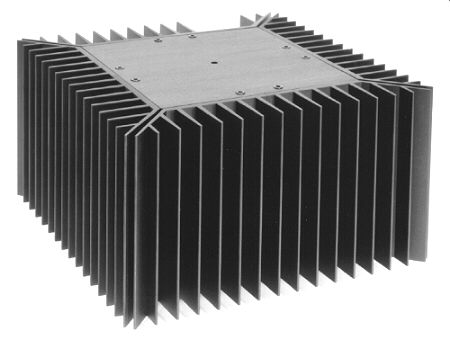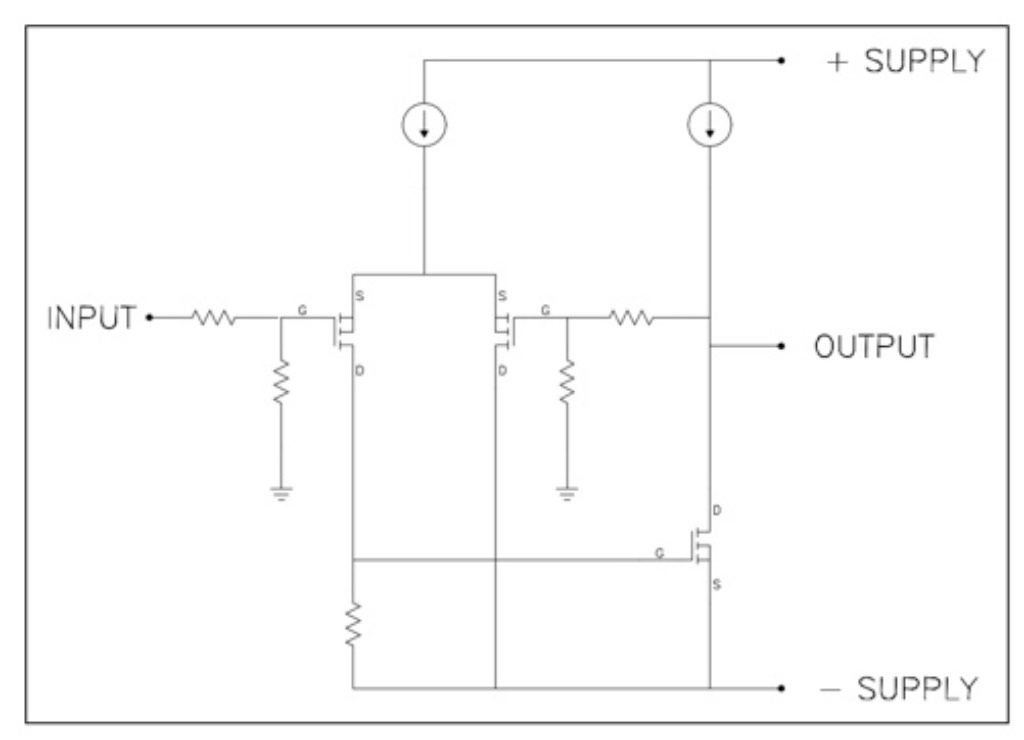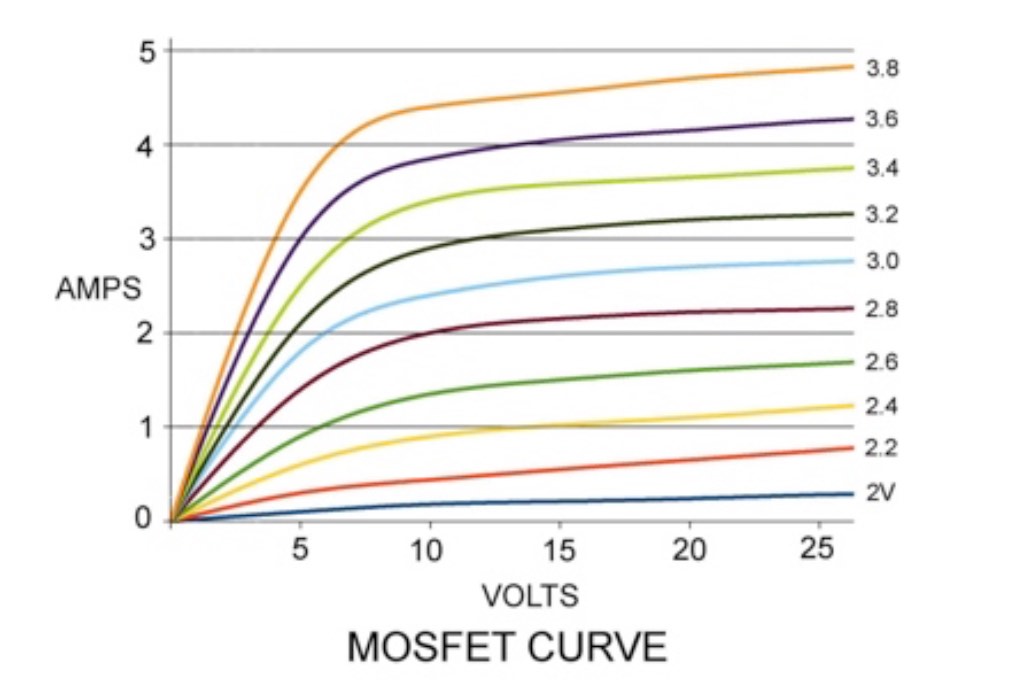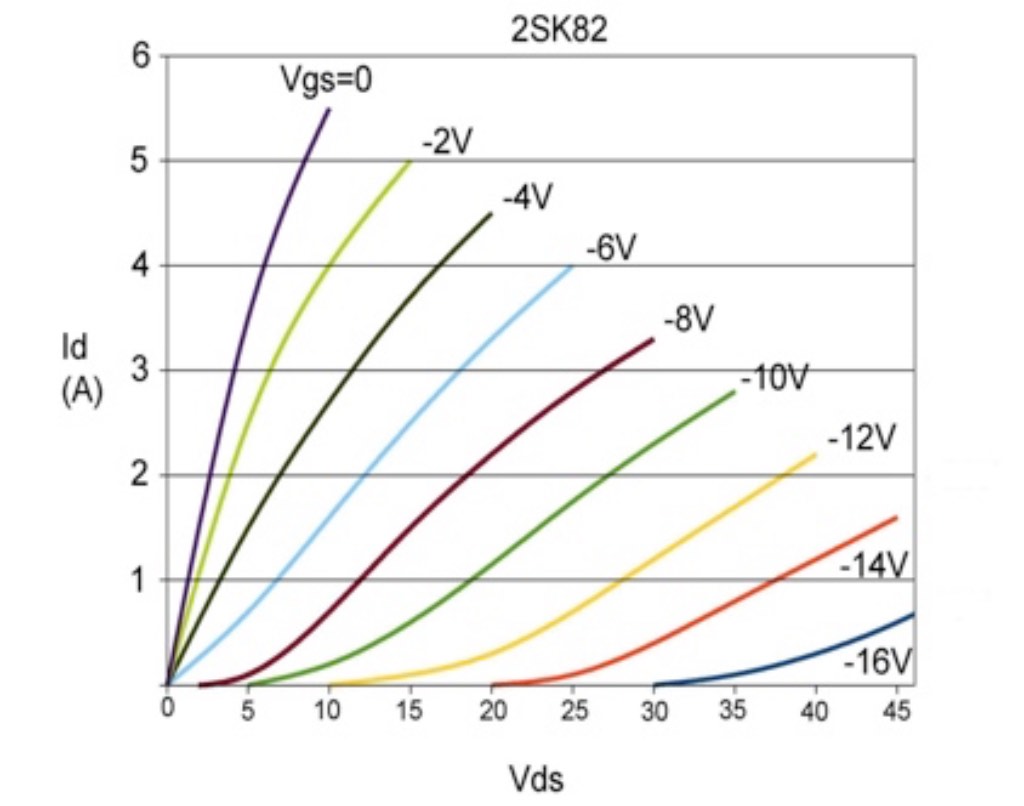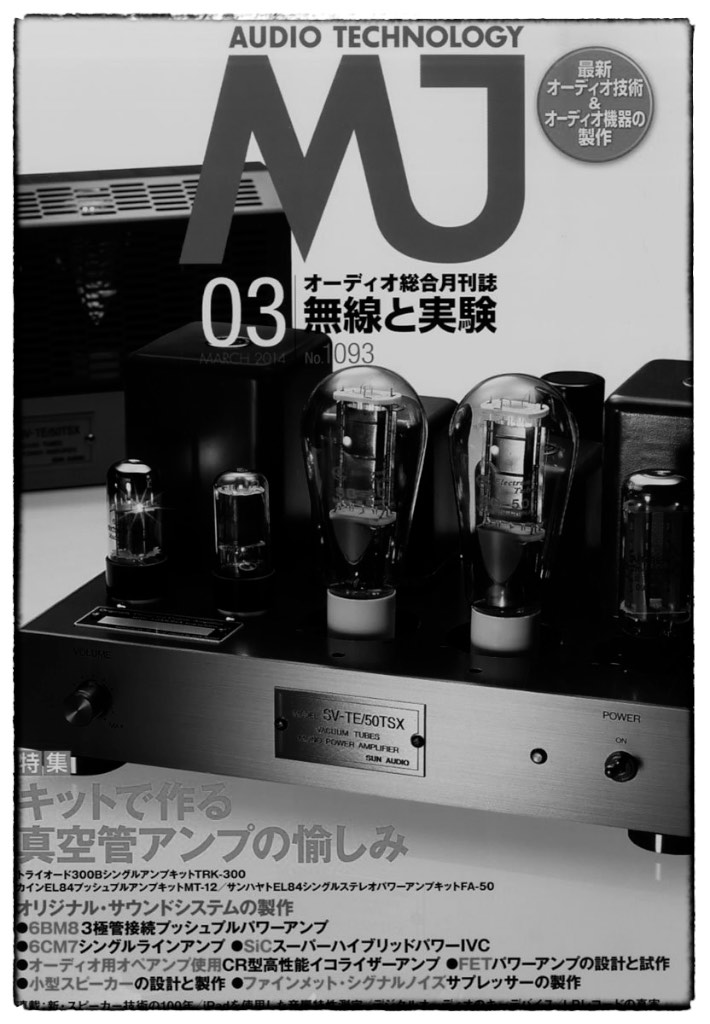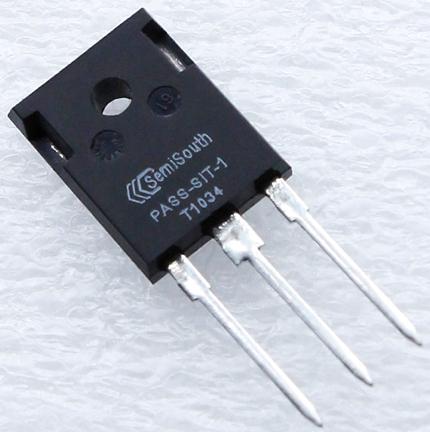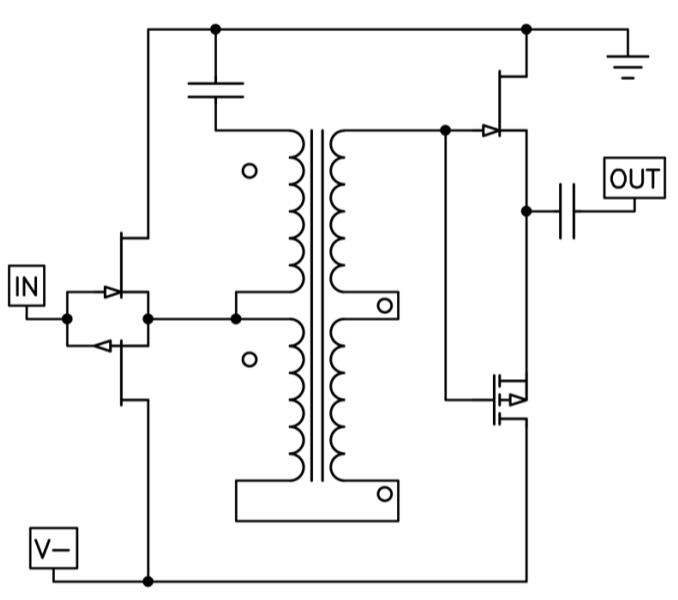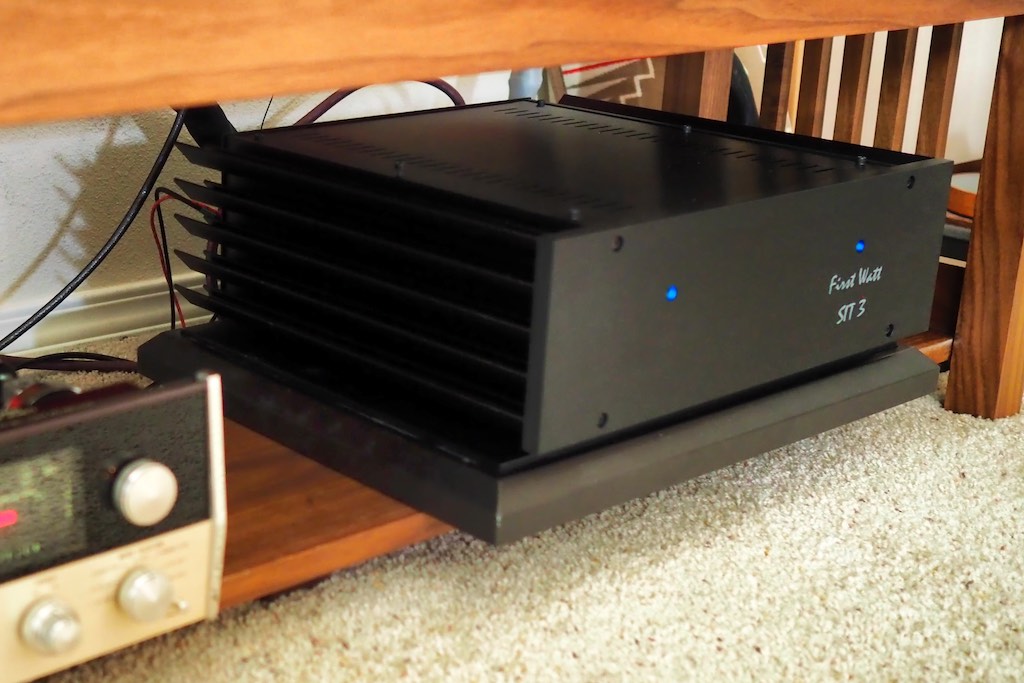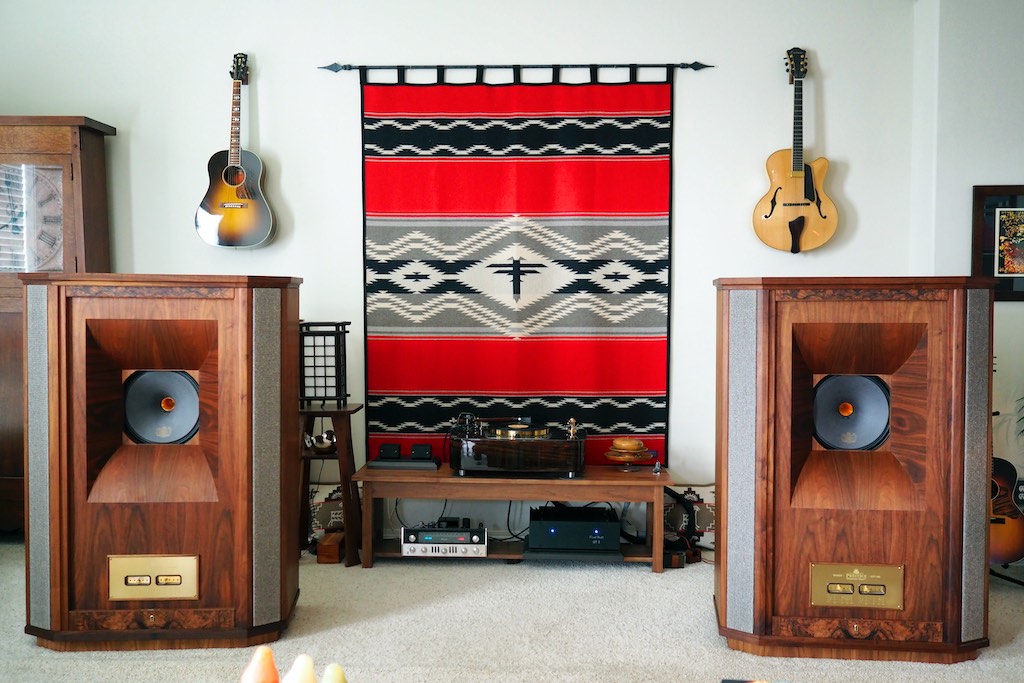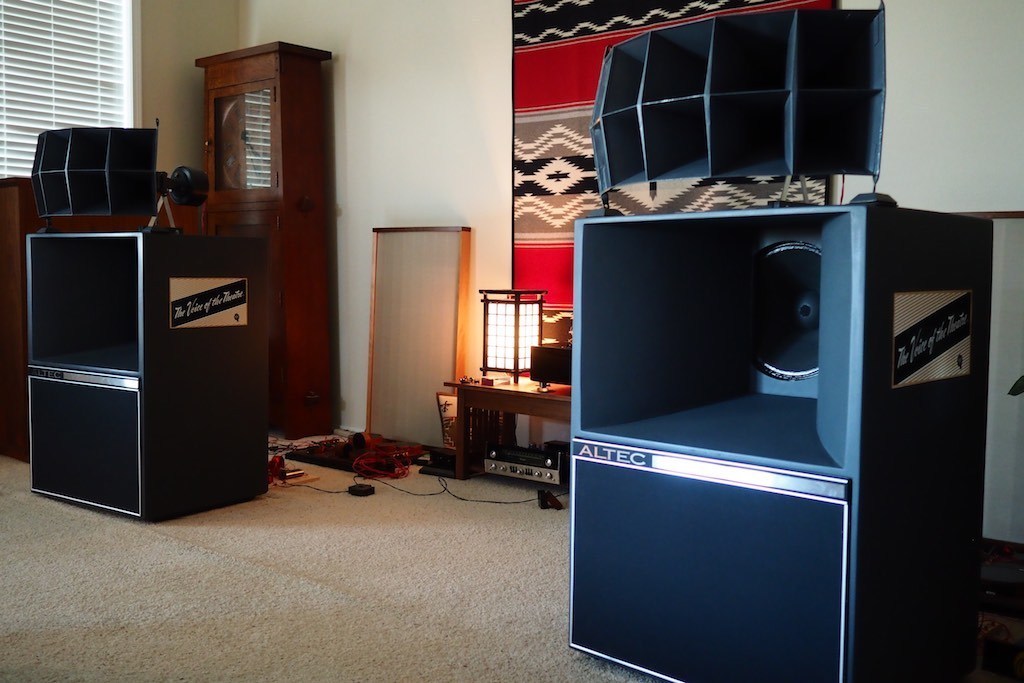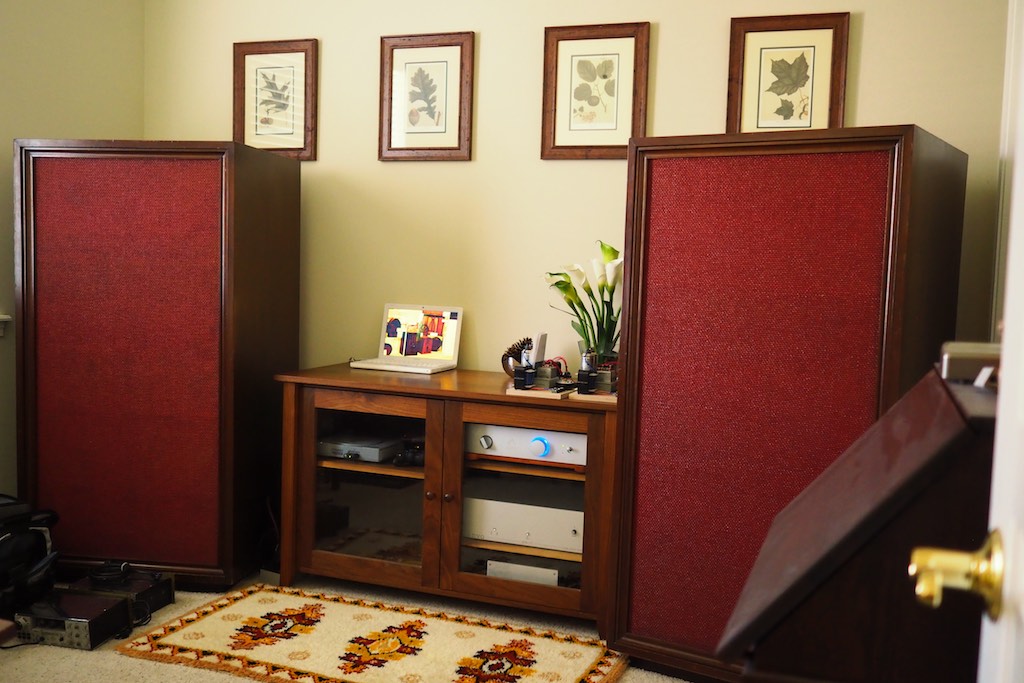A couple of memorable Pass Labs moments in my life came to mind as I have been listening to Nelson Pass' new First Watt SIT-3 stereo power amplifier over the last two weeks, a design which Nelson is very pleased with, I am told (and which I will be interviewing him about for the Positive Feedback review of the SIT-3).
Pass Labs Aleph 3 Stereo Power Amplifier
My first memorable Pass Labs moment was way back in 1997 - twenty-one years ago now - when I owned a Pass Labs Aleph 3 stereo power amplifier (below), and it was my introduction to using a solid-state amplifier versus a tube amplifier in my stereo system.
I loved the Aleph 3's no-nonsense appearance with its huge heat sinks encircling the chassis, its ultra-reliability, and its low cost of maintenance (no expensive vacuum tubes to replace), not to mention that its modest power output of 30 watts per channel sounded great on the Spendor SP-1/2 loudspeakers I had at the time.
Nelson said about his Aleph 3, "The Aleph 3 integrates power MOSFET devices and pure single ended Class A operation in a simple two-gain-stage topology with the sole purpose of recreating subjectively natural sound."
I thought the Aleph 3's price of $2400 USD was fair as well, and it was something that I could actually afford to buy as an audio enthusiast back in 1997. In 2018 dollars the Pass Labs Aleph 3 would go for $3751 USD, which is comparable to the First Watt SIT-3's price of $4000 USD.
MOSFETs have power curves that look a lot like pentode vacuum tubes, and I've enjoyed the various pentode based vacuum tube amplifiers I've had quite a lot for their unique and engaging presentation of music, just as I did the Aleph 3.
I would eventually be lured away from my Aleph 3 by the siren song of triode vacuum tubes such as the 2A3, 45, 300B, and the 845.
In the diagram above you can see the power curves for a 300B vacuum tube, and notice how it differs from the MOSFET's pentode-like power curves.
Pass Labs Sony VFET 40 Year Commemorative Amplifiers
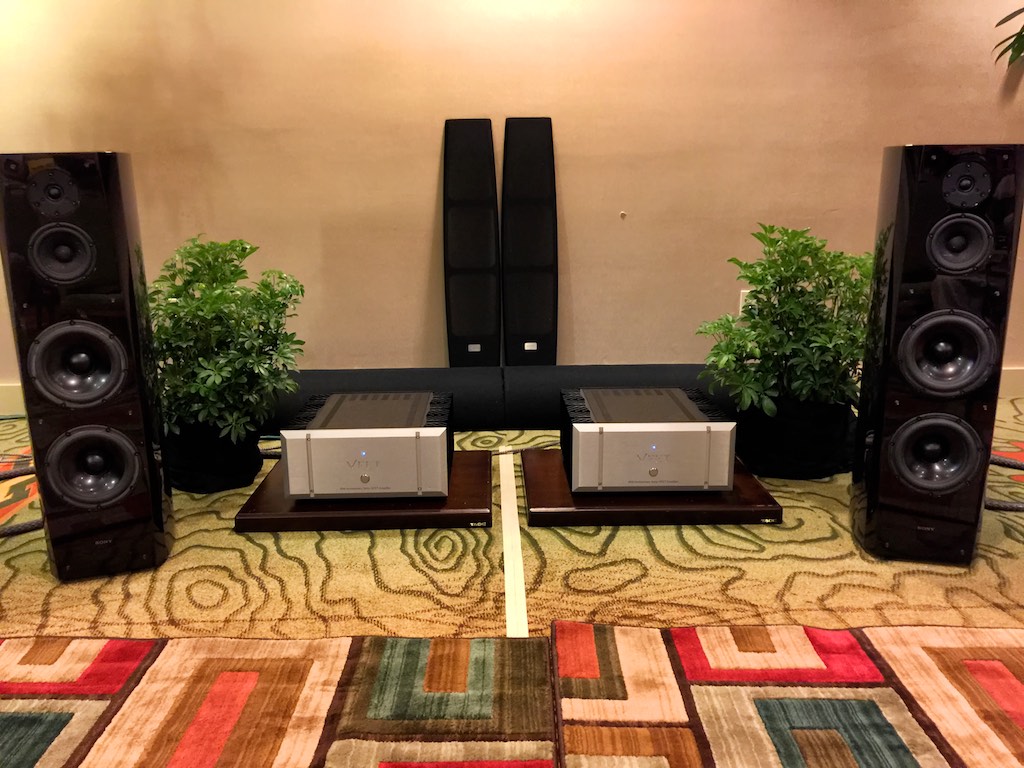
Chad Kassem’s Acoustic Sounds teamed with Sony for loudspeakers & Nelson Pass for amplification, and it was my favorite of the show, with smooth, natural, analog sound, and with Chad doing DJ duties.
My second memorable Pass Labs moment was in 2015 when I visited the Rocky Mountain Audio Fest, where I heard the best combination of musicality and sound that I've ever heard at an audio show while listening to music with Chad Kassem in his Acoustic Sounds room using the Pass Labs Sony VFET 40 Year Commemorative amplifiers driving Sony loudspeakers, using Chad's vinyl as a source. I could have easily lived with Chad's system and never looked back, it was amazing!
The Pass Labs Sony VFET 40 Year Commemorative amplifiers used Sony VFETs, which are now more commonly referred to as "SITs" to avoid confusing them with vertical MOSFETs.
As Nelson said about the Pass Labs Sony VFET 40 Year Commemorative amplifiers, "Examples of “VFETs” were produced by Sony and Yamaha forty years ago and appeared in power amplifiers produced from about 1975 through 1980. These amplifiers are now prized for their exceptional sound, the credit popularly going to the linearity of the VFETs. They were called VFETs at the time because they have a vertical (not lateral) structure. The subsequent invention and dominance of vertical MOSFETs (Metal Oxide Semiconductor Field Effect Transistor) made use of the term confusing, so now they are generally referred to as Static Induction Transistors (SIT), except perhaps as reference to these original parts."

Sony VFET / SIT used in the Pass Labs Sony VFET 40 Year Commemorative amplifiers. Photo from Nelson Pass.
I suppose the Pass Labs Sony VFET 40 Year Commemorative amplifiers could also be referred to as the Pass Labs Sony "SIT" 40 Year Commemorative amplifiers using contemporary nomenclature, and they reside in the "family tree" of SIT amplifiers that Nelson has designed.
In the above photo you can see the Sony VFETs / SITs that Nelson used in the Sony VFET 40 Year Commemorative amplifiers .
Why did I like the Pass Labs Sony VFET 40 Year Commemorative amplifiers sound so much?
Part of the reason was no doubt due to the VFETs / SITs power curves looking a lot like the power curves for triode vacuum tubes like the 300B, noted for their rich, dimensional, and natural sound quality.
Check out the similarity of the 300B power curves to the Sony 2SK82 VFETs / SITs in the power curve diagrams shown above.
The Pass Labs Sony VFET 40 Year Commemorative amplifiers didn't sound exactly like good DH-SET 300B amplifiers, they sounded much better to my ears!
Pass Labs and First Watt
I've gotten a number of questions from readers about the relationship of Pass Labs to First Watt, so before I talk more about the First Watt SIT-3 amplifier that I've been listening to for the last couple of weeks, let me explain the reason for the existence of the two Nelson Pass enterprises of Pass Labs and First Watt.
First Watt is Nelson Pass’ audio equivalent of the Lockheed Martin’s "Skunk Works" that develops advanced and/or secret aircraft projects in an environment that is unhindered by the usual commercial or bureaucratic concerns, like the famous U-2 or SR-71 Blackbird spy planes, for example.
In that same “skunk works” spirit of exploring the cutting edge of innovation, Nelson says, “First Watt exists because I wanted to explore a variety of amplifier designs in what I think of as neglected areas - amplifiers that might not fit into the mainstream and are probably not appropriate to my more commercial enterprise, Pass Labs. With oddball characteristics and output power ratings of 25 watts or less, First Watt is not for most people. If you have efficient loudspeakers, listen at reasonable levels and are obsessed about subjective performance, then you probably have come to the right place. If you want reliable audio product, then you really have come to the right place. For twelve years First Watt has had a near-zero failure rate.”
Nelson has now developed seventeen First Watt amplifiers at the cutting-edge of sound quality and musicality, and they all have 25 watts or less output into 8 Ohms.
All of the First Watt amplifiers feature minimalist circuits with little or no feedback and are highly innovative design approaches to Class A circuits, using either metal-oxide-semiconductor field-effect transistors (MOSFET), junction gate field-effect transistors (JFET), or static induction transistors (SIT), and with some of the designs being current sources instead of the more usual voltage sources, often being single-ended, and sometimes having no voltage gain at all!
Aficionados of low powered tube amplifiers ooh and ahh over the musical and sonic performance of the 300B, 2A3, 45, and PX25 vacuum tube designs developed in 1938, 1932, 1929, and 1935, respectively. The 1920’s and 1930’s were good years for developing low-powered triode vacuum tube designs.
Some audio enthusiasts may not realize that MOSFETs were developed in 1959 by Dawon Kahng and Martin M. (John) Atalla at Bell Labs; JFETs were first patented by theoretical and applied physicist Heinrich Welker in 1945 (Westinghouse and Bell Labs); and SITs were developed by Japanese engineers Jun-ichi Nishizawa and Y. Watanabe in 1950, which was also during the period that is often cited as the Golden Age of Audio.
However, until Nelson Pass and his innovative Pass Labs and First Watt designs, the same careful attention had not been applied to implementing MOSFETs, JFETs, and SITs for maximum musical and sonic performance into simple Class A circuits, as had been done by audio experimenters working with the 300B, 2A3, 45, and PX25 vacuum tubes that you might have read about in the Japanese audio experimenters periodical MJ Audio Technology (above), whose first issue was published in 1924.
Nelson Pass’ First Watt amplifier designs have often been compared to these low-powered vacuum tube single-ended-triode (SET) amplifier designs for their sheer musicality and sonic prowess, though Nelson is quick to point out that his designs “… are not designed to mimic tubes as such. These amplifiers share some of the characteristics of the better tube products in that they have simple circuits with minimal or no feedback and emphasize performance of individual gain devices. In some ways they are better than tubes, in other ways perhaps not.”
The proof is in the listening though, and if you’ve had an opportunity to listen to Nelson’s First Watt amplifiers you know they are extremely good in terms of musicality and sonics, easily competitive with the single-ended-triode (SET) vacuum tube amplifiers I have owned, with the added benefit of reasonable prices, extreme reliability, and with no expensive vacuum tubes to periodically replace the First Watt amplifiers also have very low life-cycle costs for the audio enthusiast.
The First Watt SIT-3 Stereo Amplifier

I've been listening to the First Watt SIT-3 installed into the Westminster based system for a couple weeks now.
Now let's talk a little bit about the First Watt SIT-3 from Nelson Pass that I've been listening to for the last few weeks.
In 2010 Nelson had SemiSouth make a small custom run of static induction transistors (SIT) made of silicon carbide that would deliver 10 watts into 8 Ohms, for use in upcoming First Watt amplifier designs.
In 2012 Nelson introduced the SIT-1 monaural amplifiers and the SIT-2 stereo amplifier. Nelson says about them, “Both were rated at 10 watts per channel and used the SIT as the only gain device, operated without feedback in Common Source Mode, which delivers both voltage and current gain. The two amplifiers were the most successful in the history of First Watt and were made into 2017 (emphasis mine – Jeff).”
For just a moment let’s think about Nelson’s statement that the SIT-1 and SIT-2 were the most successful amplifiers in the history of First Watt. If you’re like me you are wondering what made Nelson’s SIT-1 and SIT-2 amplifiers so successful with listeners. I think it would be too simplistic to just say that listeners liked the way they sounded, even though that’s true, the question becomes “What exactly was it that listeners liked about the way the SIT-1 and SIT-2 amplifiers sounded?’
Well, it turns out that when the static induction power transistor was developed its performance was modeled after the power curves of a triode vacuum tube, and as Nelson says, “SIT devices have a unique characteristic which is of particular value for audio amplifiers. Quoting inventor Nishizawa's patent abstract, “(The) drain-current to drain-voltage characteristic simulates the anode-current to anode-voltage characteristic of the triode vacuum tube very closely.””
It turns out that JFET’s and MOSFET’s have power curves that look a lot like a pentode vacuum tube, but the power curves for the SIT looks like a triode vacuum tube, so the answer to the single ended SIT-1 and SIT-2’s popularity was that they sounded very much like the best single ended triode (SET) vacuum tube amps. Let that sink in for a moment.
Nelson says there are three primary advantages of triode vacuum tubes and SIT power transistors for audio use. The first is that they allow you to build an amplifier with a single gain stage that provides both current and voltage gain, while having high input impedance and low output impedance, so no feedback is necessary. Secondly, you can choose a voltage-current load-line that provides very low distortion. Thirdly, their soft overload characteristics mean that when they’re driven hard to clipping they distort gracefully by producing compressed and rounded waveforms instead of unpleasant sounding sharp clipping.
Now to add to the intrigue of the popularity of the SIT-1 and SIT-2, Nelson has for 2018 released his third and final version of an amplifier based on his custom run of SemiSouth static induction transistors, the First Watt SIT-3.
The new SIT-3 is a Class A stereo amplifier using Nelson’s SemiSouth SIT power transistor and puts 10 watts into 16 Ohms (as with my vintage Altec loudspeaker collection) 18 watts into 8 Ohms (as with my Tannoy Westminster Royal SE loudspeakers), and 30 watts into 4 Ohms.
The SIT-3 differs from the SIT-1 and SIT-2 in that it operates in Common Drain Mode rather than their Common Source Mode.
Nelson explains their differing operational modes by saying, “The channels of the SIT-1 and SIT-2 consisted of a single SIT operated in Common Source Mode in which (conceptually) the signal comes into the gate and appears amplified at the drain pin, but phase inverted. The source pin is grounded. The amplification with Common Source operation is both voltage and current, and the phase inversion is corrected by reversing the output terminals. The SIT-3 goes in another direction, using Common Drain operation, where the signal goes into the gate pin and comes out the source pin and the drain of the FET is grounded (literally attached to ground). This mode only provides current gain – voltage gain is provided by a high-quality voltage step-up transformer which takes the input signal from a preamplifier (or other device) and boosts the voltage. There is no phase inversion at the loudspeaker terminals.”
Nelson goes on to say, “In both approaches, the SIT does a good job of amplifying the signal without feedback, but Common Drain operation delivers the amplification with much lower distortion and noise and also a much better damping factor for the loudspeaker. The trade-off is the addition of the input transformer, but I think you will find the compromise there is small with respect to the sound quality. Common Drain has the same simple spectral distortion character that graced the SIT-1 and SIT-2 and allows similar control of the amplitude and phase of the second harmonic content, but at a much lower distortion figure.”
If you look closely at the power output of the SIT-1, SIT-2, and SIT-3, you’ll notice that the SIT-3 outputs 18 watts into 8 Ohms, almost double the 10 watts into 8 Ohms of the SIT-1 and SIT-2.
I asked Nelson how the SIT-3 achieves an output of 18 watts compared to the SIT-1 and SIT-2’s 10 watts, given that they both share the same SemiSouth SIT power transistor.
Nelson said, “It (the SIT-3) is unique because it operates in a push-pull topology I call DEF - the depletion type N channel SIT is mated with an enhancement type P channel MOSFET to form a self-biasing Class A power follower. Apart from elegant simplicity, this has the square-law character of a triode circuit but with more current available to the load. Compared to the single-ended SIT-1 and 2, this push-pull Class A has twice the power into 8 ohms, eight times the power into 4 ohms, 10 times the damping factor, and one-fifth the distortion while having that second harmonic character. This follower stage does not provide voltage gain, so the SIT-3 uses a high-quality auto-former to boost the preamp voltage by 11 dB, buffered by push-pull JFET followers to give an input impedance of 200K Ohms."
Simply speaking, the output stage of the SIT-3 is a push-pull depletion/enhancement mode follower (DEF) which delivers about twice the output current of the single-ended SIT-1 and SIT-2 amplifiers.
Here’s a circuit schematic of the First Watt SIT-3 stereo amplifier:
About it Nelson says, “You can see the input JFET followers driving the auto-former, which develops voltage gain for the power output followers. Besides the unusual DEF / SIT output stage, you might notice the inverted power supply, which dramatically reduces supply noise seen by the SIT. This design requires careful selection of the characteristics of each SIT matched to the MOSFET – their gate voltages must be carefully matched, and fortunately this SIT device falls into the range where such matching is possible. The actual circuit is hardly more complicated and includes a few new tricks to get both the purest square-law performance with solid stability.”
I should mention that Nelson is very proud of the First Watt SIT-3 and how it turned out, and he says, “This is one of those all-night, year-after-year pieces.”
After the First Watt SIT-3 from Nelson arrived, I replaced my usual vintage McIntosh MC30 monaural amplifiers with the First Watt SIT-3 stereo amplifier in my Tannoy Westminster Royal SE based system.

Classic Turntable Company hot-rodded Garrard 301, vintage McIntosh MX110Z tuner-preamplifier, and First Watt SIT-3 stereo power amplifier.
I'm probably about half-way through the normal 100 hour run-in on the First Watt SIT-3, and its performance seems to have largely stabilized now, and it is playing music very nicely.
I had abandoned the use of 45, 2A3, and 300B amplifiers after living with my Tannoy Westminster Royal SE loudspeakers for the last so many years, as none of them really had enough power to achieve natural sounding live-like levels on the Westminster’s, and even my 25 watts per channel vintage McIntosh MC225 fell just shy of being able to maintain live-like levels in the range of 92dB-98dB SPLs across a broad range of musical genres.
My 30 watts per channel vintage McIntosh MC30 monaural amplifiers power the Westminster's quite easily, and seem to be at the sweet-spot for attaining live-like SPL’s, with more power than that just contributing a sense of ease to the Westminster’s overall presentation of music.
I wondered how well the First Watt SIT-3 at 18 watts per channel output would be able to drive my Westminster’s to live-like levels. The answer is that the SIT-3 does pretty well on most of the music I enjoy listening to, being able to do natural sounding SPL’s in the 80-90db range rather easily.
Once I got into the SPL range of 90-100dB (I even saw occasional peaks of 101dB SPL on some music), most of the time everything sounded fine, but it was clear that the nearer I got to the 100dB SPL level the SIT-3 began to sound stressed on my Westminster’s.
You can only expect so much volume-wise driving the Westminster's with the First Watt SIT-3's 18 watts, which by the way was similar to my results with the 25 watts per channel vintage McIntosh MC225 stereo amplifier on the Westminster's.
If you are considering purchasing a First Watt SIT-3 of your own, you will want to make sure that in combination with your favored loudspeakers you are able to achieve the SPL levels you enjoy listening at, which will be a little different for everybody I suppose.
My vintage Altec 832A Corona, vintage Altec A7 Voice of the Theatre, and vintage Altec A5 Voice of the Theatre loudspeakers are all much easier to drive than my Westminster's, and I suspect the First Watt SIT-3's 10 watts into 16 Ohms will be plenty of power to easily drive my vintage 16 Ohm Altec's to live-like levels, about which I will be reporting on in-depth in my upcoming Positive Feedback review of the First Watt SIT-3.
I have been having a blast listening to the First Watt SIT-3 in my Westminster loudspeakers based system, and I have been very impressed with the musicality and sonic prowess of the SIT-3 in my preliminary listening.
In the upcoming Positive Feedback review of the First Watt SIT-3 I will discuss its musicality & sonic performance in detail in several different system contexts, but for now suffice it to say that the SIT's musicality performance on the basic elements of music were extremely good in terms of timbral realism (the unique 'voices' of instruments), the resolution of tone color (the ability to distinctly hear the chordal variations resulting from adding additional pitches to three tone triads), melody (the tune you 'whistle while you work'), harmony (treble & bass accompaniments to the melody), rhythm (the steady beat that determines the tempo), tempo (speed), and dynamics (variations in loudness).
Likewise, I found the SIT-3's sonic performance to be superb with respect to transparency (the ability to 'see' into the recording), resolution (the amount of detail in the audio signal that is audibly presented), soundstage (the ability to discern the three dimensions of the recorded space in width, height and depth), the soundspace (the ability to convey the acoustic sense of 'space' of the recording venue), and imaging (the ability to localize instruments & musicians on the soundstage).
Above all the way Nelson has voiced the First Watt SIT-3 beautifully integrates musicality & sonics in a way that I've found to maximize my emotional response to the music during my listening experiences, and there were times when I was absolutely in awe of the SIT-3's way with the music.
I suspect that the First Watt SIT-3's smooth, natural, vividly present sound quality will really appeal to a lot of listeners, and it certainly appeals to me.
How good is the First Watt SIT-3 stereo amplifier? Another reviewer mentioned to me that the First Watt SIT-3 is the best amplifier he has ever heard.
I can tell you that if you're interested in a First Watt SIT-3 of your own you will want to act quickly, as there will not be many of them made, and once they are gone that will be it.
As always, thanks for stopping by, and may the tone be with you!




